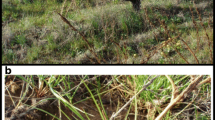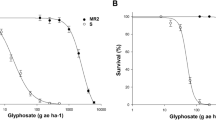Abstract
This study investigates mechanisms of multiple resistance to glyphosate, acetyl-coenzyme A carboxylase (ACCase) and acetolactate synthase (ALS)-inhibiting herbicides in two Lolium rigidum populations from Australia. When treated with glyphosate, susceptible (S) plants accumulated 4- to 6-fold more shikimic acid than resistant (R) plants. The resistant plants did not have the known glyphosate resistance endowing mutation of 5-enolpyruvylshikimate-3 phosphate synthase (EPSPS) at Pro-106, nor was there over-expression of EPSPS in either of the R populations. However, [14C]-glyphosate translocation experiments showed that the R plants in both populations have altered glyphosate translocation patterns compared to the S plants. The R plants showed much less glyphosate translocation to untreated young leaves, but more to the treated leaf tip, than did the S plants. Sequencing of the carboxyl transferase domain of the plastidic ACCase gene revealed no resistance endowing amino acid substitutions in the two R populations, and the ALS in vitro inhibition assay demonstrated herbicide-sensitive ALS in the ALS R population (WALR70). By using the cytochrome P450 inhibitor malathion and amitrole with ALS and ACCase herbicides, respectively, we showed that malathion reverses chlorsulfuron resistance and amitrole reverses diclofop resistance in the R population examined. Therefore, we conclude that multiple glyphosate, ACCase and ALS herbicide resistance in the two R populations is due to the presence of distinct non-target site based resistance mechanisms for each herbicide. Glyphosate resistance is due to reduced rates of glyphosate translocation, and resistance to ACCase and ALS herbicides is likely due to enhanced herbicide metabolism involving different cytochrome P450 enzymes.




Similar content being viewed by others
References
Baerg RJ, Barrett M, Polge ND (1996) Insecticide and insecticide metabolite interactions with cytochrome P450-mediated activities in maize. Pestic Biochem Physiol 55:10–20
Baerson SR, Rodrigues DJ, Biest NA, Tran M, You J, Kreuger RW, Dill GM, Pratley JE, Gruys JK (2002) Investigating the mechanism of glyphosate resistance in rigid ryegrass (Lolium rigidum). Weed Sci 50:721–730
Christopher JT, Preston C, Powles SB (1994) Malathion antagonizes metabolism-based chlorsulfuron resistance on Lolium rigidum. Pestic Biochem Physiol 49:172–182
Cromartie TH, Polge ND (2000) An improved assay for shikimic acid and its use as a monitor for the activity of sulfosate. In: Proceedings of the Weed Science Society of America 40:291
Délye C, Menchari Y, Guillemin JP, Matéjicek A, Michel S, Camilleri C, Chauvel B (2007) Status of black grass (Alopecurus myosuroides) resistance to acetyl-coenzyme A carboxylase inhibitors in France. Weed Res 47:95–105
Dinelli G, Marotti I, Bonetti A, Minelli M, Catizone P, Barnes J (2006) Physiological and molecular insight on the mechanisms of resistance to glyphosate in Conyza canadensis (L.) Cronq. biotypes. Pestic Biochem Physiol 86:30–41
Dinelli G, Marotti I, Catizone P, Bonetti A, Urbano JM, Barnes J (2008) Physiological and molecular basis of glyphosate resistance in Conyza bonariensis biotypes from Spain. Weed Res 48:257–265
Feng PCC, Tran M, Chiu T, Sammons RD, Heck GR, CaJacob CA (2004) Investigations into glyphosate-resistant horseweed (Conyza canadensis): retention, uptake, translocation, and metabolism. Weed Sci 52:498–505
Gaines T, Preston C, Shaner D, Leach J, Chisholm S, Bukun B, Ward S, Culpepper AS, Tranel P, Westra P (2009) A novel mechanism of resistance to glyphosate in Palmer amaranth (Amaranthus palmeri). In: Proceedings of the Weed Science Society of America, abstract No. 368
Geiger DR, Fuchs MA (2002) Inhibitors of aromatic amino acid biosynthesis (glyphosate). In: Boger P, Wakabayashi K, Hirai K (eds) Herbicide classes in development. Springer, Heidelberg, pp 59–85
Heap IM (2009) International survey of herbicide-resistant weeds. Available at http://www.weedscience.org. Accessed July 2009
Hidayat I, Preston C (2001) Cross-resistance to imazethapyr in a fluazifop-P-butyl-resistant population of Digitaria sanguinalis. Pestic Biochem Physiol 71:190–195
Jasieniuk M, Ahmad R, Sherwood AM, Firestone JL, Perez-Jones A, Lanini WT, Mallory-Smith C, Stednick Z (2008) Glyphosate-resistant Italian ryegrass (Lolium multiflorum) in California: distribution, response to glyphosate, and molecular evidence for an altered target enzyme. Weed Sci 56:496–502
Koger CH, Reddy KN (2005) Role of absorption and translocation in the mechanism of glyphosate resistance in horseweed (Conyza canadensis). Weed Sci 53:84–89
Koop DR (1990) Inhibition of ethanol-inducible cytochrome P450 by 3-amino-1,2,4-triazole. Chem Res Toxicol 3:377–383
Kreuz K, Fonne-Pfister R (1992) Herbicide-insecticide interaction in maize: malathion inhibits cytochrome P450-dependent primisulfuron. Pestic Biochem Physiol 43:232–240
Legleiter TR, Bradley KW (2008) Glyphosate and multiple herbicide resistance in common waterhemp (Amaranthus rudis) populations from Missouri. Weed Sci 56:582–587
Lorraine-Colwill DF, Powles SB, Hawkes TR, Hollinshead PH, Warner SAJ, Preston C (2003) Investigation into the mechanism of glyphosate resistance in Lolium rigidum. Pestic Biochem Physiol 74:62–72
Michitte P, De-Prado R, Espnoza N, Ruiz-Santaella JP, Gauvrit C (2007) Mechanism of resistance to glyphosate in ryegrass (Lolium multiflorum) biotype from Chile. Weed Sci 55:435–440
Nandula VK, Reddy KN, Poston DH, Rimando AM, Duke SO (2008) Glyphosate tolerance mechanism in Italian ryegrass (Lolium multiflorum) from Mississippi. Weed Sci 56:344–349
Neve P, Sadler J, Powles SB (2004) Multiple herbicide resistance in glyphosate-resistant rigid ryegrass (Lolium rigidum) population. Weed Sci 52:920–928
Owen MJ, Powles SB (2009a) Glyphosate-resistant rigid ryegrass (Lolium rigidum) populations in the Western Australian grainbelt. (submitted to Weed Technol)
Owen MJ, Powles SB (2009b) Distribution and frequency of herbicide-resistant wild oat (Avena spp.) across the Western Australian grain belt. Crop Pasture Sci 60:25–31
Owen MJ, Walsh M, Llewellyn R, Powles SB (2007) Widespread occurrence of multiple herbicide resistance in Western Australian annual ryegrass (Lolium rigidum) populations. Aust J Agric Res 58:711–718
Perez-Jones A, Kogan M (2003) Glyphosate-resistant Lolium multiflorum in Chilean orchards. Weed Res 43:12–19
Perez-Jones A, Park KW, Colquhun J, Malory-Smith C, Shaner D (2005) Identification of glyphosate resistant Italian ryegrass (Lolium multiflorum) in Oregon. Weed Sci 53:775–779
Perez-Jones A, Park KW, Polge N, Colquhoun J, Mallory-Smith CA (2007) Investigating the mechanism of glyphosate resistance in Lolium multiflorum. Planta 226:395–405
Powles SB (2008) Evolved glyphosate-resistant weeds around the world: lessons to be learnt. Pest Manag Sci 64:360–365
Powles SB, Preston C (2006) Evolved glyphosate resistance in plants: biochemical and genetic basis of resistance. Weed Technol 20:282–289
Powles SB, Lorraine-Colwill DF, Dellow JJ, Preston C (1998) Evolved resistance to glyphosate in rigid ryegrass (Lolium rigidum) in Australia. Weed Sci 46:604–607
Pratley J, Urwin N, Stanton R, Baines P, Broster J, Cullis K, Schafer D, Bohn J, Krueger R (1999) Resistance to glyphosate in Lolium rigidum. I. Bioevaluation. Weed Sci 47:405–411
Preston C, Powles SB (1998) Amitrole inhibits diclofop metabolism and synergises diclofop-methyl in a diclofop-methyl-resistant biotype of Lolium rigidum. Pestic Biochem Physiol 62:179–189
Preston C, Wakelin AM (2008) Resistance to glyphosate from altered herbicide translocation patterns. Pest Manag Sci 64:372–376
Preston C, Tardif FJ, Christopher JT, Powles SB (1996) Multiple resistance to dissimilar herbicide chemistries in a biotype of Lolium rigidum due to enhanced activity of several herbicide degrading enzymes. Pestic Biochem Physiol 54:123–134
Rechsteiner MP, Widmer F, Kölliker R (2006) Expression profiling of Italian ryegrass (Lolium multiflorum Lam.) during infection with the bacterial wilt inducing pathogen Xanthomonas translucens pv. graminis. Plant Breed 125:43–51
Shaner DL (2009) The role of translocation as a mechanism of resistance to glyphosate. Weed Sci 57:118–123
Simarmata M, Penner D (2008) The basis for glyphosate resistance in rigid ryegrass (Lolium rigidum) from California. Weed Sci 56:181–188
Simarmata M, Kaufmann JE, Penner D (2003) Potential basis of glyphosate resistance in California rigid ryegrass (Lolium rigidum). Weed Sci 51:678–682
Singh BK, Shaner DL (1998) Rapid determination of glyphosate injury to plants and identification of glyphosate resistant plants. Weed Technol 12:527–530
Steinrucken H, Amrhein N (1980) The herbicide glyphosate is a potent inhibitor of 5-enolpyruvylshikimic acid-3-phosphate synthase. Biochem Biophys Res Commun 94:1207–1212
Wakelin AM, Preston C (2006) A target-site mutation in 5-enolpyruvylshikimate-3-phosphate synthase is present in a glyphosate-resistant Lolium rigidum (Gaud.) population. Weed Res 44:453–459
Wakelin AM, Lorraine-Colwill DF, Preston C (2004) Glyphosate resistance in four different populations of Lolium rigidum is associated with reduced translocation of glyphosate to meristematic zones. Weed Res 44:453–459
Yang CS, Tu YY, Koop DR, Coon MJ (1985) Metabolism of nitrosamines by purified rabbit liver cytochrome P450 isozymes. Cancer Res 45:1140–1145
Yu Q, Friesen LJS, Zhang XQ, Powles SB (2004) Tolerance to acetolactate synthase and acetyl-coenzyme A carboxylase inhibiting herbicides in Vulpia bromoides is conferred by two co-existing resistance mechanisms. Pestic Biochem Physiol 78:21–30
Yu Q, Cairns A, Powles SB (2007a) Glyphosate, paraquat and ACCase multiple herbicide resistance evolved in a Lolium rigidum biotype. Planta 225:499–513
Yu Q, Collavo A, Zheng MQ, Owen M, Sattin M, Powles SB (2007b) Diversity of acetyl-coenzyme A carboxylase mutations in resistant Lolium populations: evaluation using clethodim. Plant Physiol 145:547–558
Yuan JS, Tranel PJ, Stewart CN (2007) Non-target-site herbicide resistance: a family business. Trends Plant Sci 12:6–13
Acknowledgment
This research is partially funded by the Australian Research Council. A fellowship for Dr I Abdallah from the Ministry of Higher Education and State for Scientific Research of Egypt is gratefully acknowledged.
Author information
Authors and Affiliations
Corresponding author
Rights and permissions
About this article
Cite this article
Yu, Q., Abdallah, I., Han, H. et al. Distinct non-target site mechanisms endow resistance to glyphosate, ACCase and ALS-inhibiting herbicides in multiple herbicide-resistant Lolium rigidum . Planta 230, 713–723 (2009). https://doi.org/10.1007/s00425-009-0981-8
Received:
Accepted:
Published:
Issue Date:
DOI: https://doi.org/10.1007/s00425-009-0981-8




